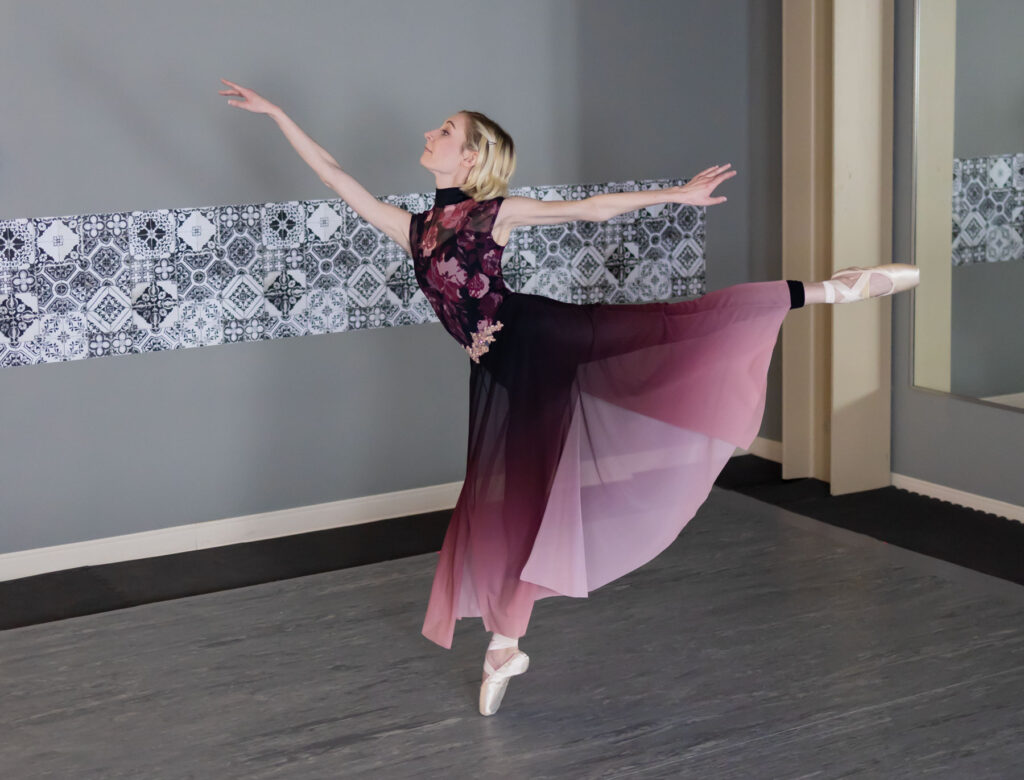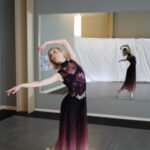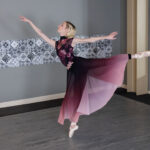Ballet dancer/teacher Emmy Mertens creates stories of hope and redemption.
When she pushed the play button, ready to create a solo ballet performance to the soul stirring Pentatonix cover of “Mary Did You Know?,” there was no music. Only silence. But the camera was already rolling.
Instead of accepting panic, Emerson Mertens immersed herself in the storytelling — and the story — and she danced, connecting with her Creator in silence, save for the graceful moves and motions that gently sliced the air and swished the floor at the City Ballet Theater in Columbia. Dancing without music was unusual; even more curious was creating choreography to a Christmas classic in July.
Emerson, or “Emmy,” is a professionally-trained ballet dancer and teacher, and the artistic director and co-creative director of City Ballet Theater, located in north Columbia at 2601 Rangeline St., on the lower level of the Wilson’s Fitness building. Emmy, 28, originally from California, Mo., is also COMO Magazine’s “Columbia’s Got Talent” winner for 2023, based in part on a nomination from her mom, Heather Mertens. Heather is the administrative director and co-creative director at City Ballet Theater, which opened in July 2022.
“I knew I wanted to do a Christmas show as soon as we could when we opened,” Emmy says. “And that song …” Her voice turns to a whisper. “That song, especially the Pentatonix version, that’s just incredible.” She wanted to record her dance for an opportunity to work on it more and to show her ballet students and others.
‘This is what I’m about’
It was also important to Emmy and Heather to make a statement, via ballet, about their strong faith.
“And I just felt like I knew God wanted me to do it,” Emmy says. “And He provided a way. I did the entire thing in one take — no choreography, just improv based on the lyrics and the music that I remembered.”
Later, when she used an editing program to add the music to the video, the dance matched the music.
“Perfectly,” Heather recalls. “So, I cried when I saw it.”
And the statement they were hoping to make?
“This is what we’re about,” Emmy explains. “This is what I’m about.”
Emmy repeated the dance at the studio’s Christmas performance, which also featured her students ranging in age from 3 years old to adults. They performed The Nutcracker with 16 students. The studio opened with six students, and the number has grown to around 30, which includes a class for adults as well as former dancers who wanted to return to their art in CBT’s setting.
By the way, The Nutcracker drew an attendance of 196 people.
“Our first show was phenomenal,” Emmy says. “That was incredible.”
A journey of pain — and hope
Heather describes CBT as a professional dance company and pre-professional dance school, combining dance and theater, that opened to be “a family-friendly, classical dance school.”
Heather and Emmy both sprinkle their comments with enthusiastic, even glowing, adjectives. But there’s something to know about the journey that led the duo to open CBT about eight months ago. Emmy dances and choreographs despite having two diseases that affect her muscles, organs, central nervous system, and connective tissue.
You know, there’s a lot of hidden pain, especially hidden
Emmy Mertens
emotion and physical pain. It’s so freeing not to have to hide that.
The first is called Hypermobile Ehlers-Danlos syndrome, or hEDS, that is caused by defects in the protein collagen. Symptoms include joint hypermobility — “I can move in ways that I really shouldn’t necessarily be able to, as a human,” Emmy explains — affecting both large and small joints (elbows and knees, fingers and toes), and soft, smooth skin that may be slightly elastic and bruises easily. More severe forms of Ehlers-Danlos syndrome affect blood vessel walls and organs.
Chronic muscle and bone pain is the main calling card and can be debilitating. Emmy wasn’t diagnosed (after years of misdiagnoses) until she was 19. Both Heather and Emmy also have fibromyalgia, a chronic disorder that causes pain and tenderness throughout the body, as well as fatigue and trouble sleeping.
“It’s truly a miracle that she dances and choreographs,” Heather wrote in the COMO’s Got Talent nomination email. Emmy had given up dancing for about five years and wasn’t sure she’d return to the storytelling art that she loved.
Emmy gives some examples of how hEDS affects her. Sometimes if she bends her knee incorrectly, a tendon will slip because the tissue around it is weakened by the lack of collagen. There are times when she rolls over her knees in certain ways that the “band” on the side of joint slips out and her leg gets caught at a backwards angle.
“It causes a tremendous amount of pain — the worst pain I’ve ever felt, actually,” she explains. “So I would literally have to physically pop my leg back to where it was supposed to be.”
Hundreds of sleepless nights
Because the condition affects ligaments and tissues, slipping joints and bones can create problems in her rib cage.
“It makes it hard to breathe” at times, Emmy adds. “And then I can only take shallow breaths.”
Heather says those episodes can last anywhere from 30 seconds to three hours.
“Sometimes there were countless — probably hundreds of nights when she was growing up — that I would spend in her room at night,” Heather adds. “We would spend hours crying, lying in bed, just crying through it and praying.”
Emmy takes medication to help manage pain. She and Heather have both become familiar with homeopathic and dietary treatments, too. Getting rest is the primary method of dealing with the pain and fatigue. But the best pain management comes through dance and faith, Heather says.
“Now she has her own place to inspire others,” Heather says. “She encourages others to pursue dancing despite their life obstacles.”
Emmy has been trained by some of the top dancers and instructors in the country and, at the age of 9, she choreographed her first dance — for the Manhattan Dance Project showcase. She danced the lead role of Clara in The Nutcracker with the Minnesota Ballet at age 12 and started her first dance company when she was 17. Emmy earned a Bachelor of Science in religion (Biblical and theological studies) with an emphasis on digital arts from Liberty University.
While her talent has provided opportunities to travel far and wide, the Mertens have called Columbia home for the last 10 years.”
Heather adds, “It’s been a long journey.”
Ballet provokes wonder, emotion, and connection. As an art form of movement created by the human body, ballet can — intended or not — be sensual and provocative. CBT’s dress code spells out the importance of keeping “all attire modest and appropriate.” Ballet can also “be sort of a mirror for society” in the ways that male and female dancers interact with each other.
Now she has her own place to inspire others.
Heather Mertens, about her daughter, Emmy
She encourages others to pursue dancing despite their life obstacles.
“It is true that dance, it’s a physical art form and sport, in some ways” can be sensual and provocative, Emmy says. “There is that element of physicality that sometimes, I think, goes too far in this world. So we’re trying to take the redeeming qualities of that and see it as God gave you these bodies and you can use them in ways that are positive and family-friendly and can also give glory to Him and how He made you.”
The power of words and dance
For dancers and students, the environment itself can be “very self-deprecating,” Emmy says.
“A lot of body image issues come out of dance because you’re constantly staring in the mirror and there’s costuming and everything,” she explains. CBT class time takes time out for healthy snacks to model good nutrition. Emmy recalls several experiences in her training that were not positive — and instilled poor coping habits.
“That’s a pattern we have as dancers. Being very hard on yourself,” she says, recalling previous experiences. “People can be hard on you, too. And the dancers aren’t always nice to each other, unfortunately.” Emmy began ballet at age 4 and when she began showing symptoms of hEDS, some of her teachers said she was “just lazy.”
“And it was very hard. Because you start to believe what you’re told,” she explains. “If somebody tells you something over and over, if you tell yourself something over and over, it’s very powerful.”
City Ballet Company is built on a different philosophy that aims to uphold a positive body image and the importance of self-care, rather than training through pain or injuries. Emmy says she is deliberate about not hiding her physical struggles, which is counter to what part of the dance world teaches: “Don’t tell anybody what you’re going through.” CBT strives for students to be “precise, not perfect.”
“You know, there’s a lot of hidden pain, especially hidden emotion and physical pain,” she adds. “It’s so freeing not to have to hide that.”
Motivated by faith
A year ago, Emmy was pondering plans to move to Florida and open a dance school. The warmer climate would be a reprieve from cold weather that exacerbated her joint pain. But a feeling — a calling? — that she was supposed to stay in Columbia lingered and moved her and Heather to begin looking for studio space in Columbia.
Within two weeks, they discovered a space for lease just two doors down from Lakota, their favorite coffee shop, in the Wilson’s Fitness building. Heather credits Wilson’s owners Terry Wilson and J.D. Abrams for their response to a dance studio.
“They loved our concept. They loved that we were fitness-based,” Heather adds. “They were amazing and worked with us and just helped us to make this space our own.”
City Ballet Company is preparing for an upcoming performance of Sleeping Beauty, a variety show, and an Easter season performance that will tell the story of the death and resurrection of Christ.
“Our faith is what motivates us,” Emmy says, “and that’s our mission, to be that positive influence because of what God did for us and what Jesus did for us. We want to show that love to other people.”
City Ballet Company
2601 Rangeline St, Ste 105
dance@cityballettheater.com
cityballettheater.com















